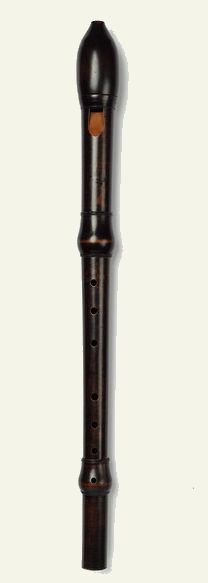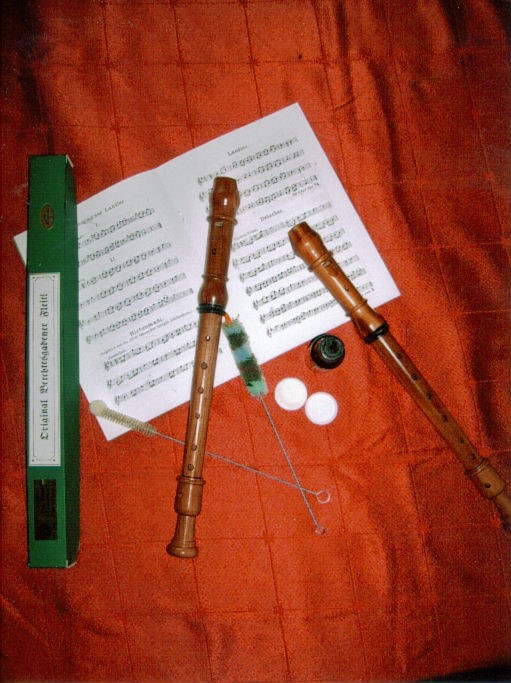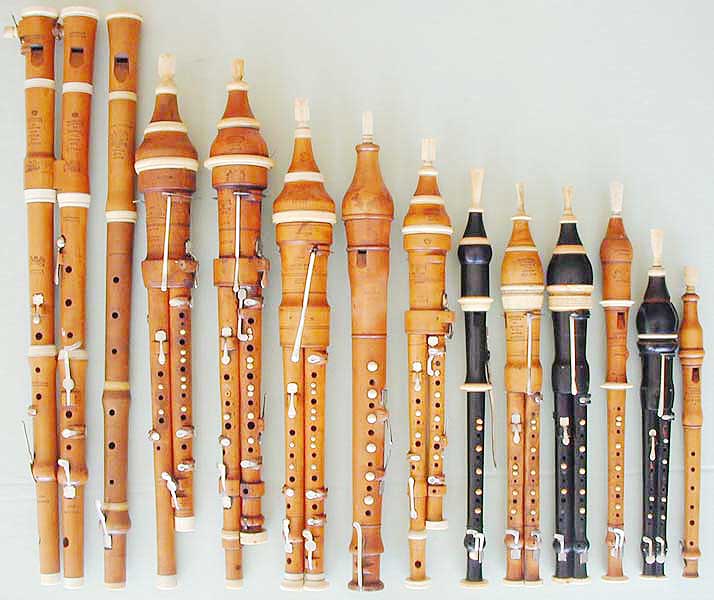It has been argued cogently that the recorder actually has a continuous existence from the 18th into the 19th century (Reyne 1985, Heberle and Reyne 1987). In the USA the recorder was played well into the mid-19th century (Lasocki 2009). In Europe, three generations of the Walch family of Berchtesgaden, Germany, made recorders, namely Lorenz Walch (mid-19th century), Lorenz Walch II (fl. 1809–1862) and Paul Walch (c. 1862–1873), extant instruments by all of whom are documented by Young (1993: 249–251) and Lander (1996–2025).
Indeed, the so-called Berchtesgadener Fleitl continues to be made to this day by Bernhard Oeggl, whose great-grandfather Georg Eckl learnt his craft from Paul Walch (MacMillan 2007: 194, 2008: 113-119). Similarly, Thalheimer (2005) has traced the careers of the Schlosser family of woodwind makers from the towns of Oberzwota and Zwota over five generations. Their founder was Johan Gabriel Sr who was active in the early 19th century; Rüdinger, who seems to have been the last maker, died in 2005. Heinrich Oskar (1875–1947) made instruments sold by the firm of Moeck in Celle and helped to design their Tuju series of recorders.
In England, Goulding & Co. (c. 1786–1834) made recorders, as did John Townsend (c. 1816–1869) in Manchester (Blanchfield, 1972). Corcoran (1965) notes that Thomas Davies, of Halkwin, Flintshire, England, who was born in the 1830s, possessed an 18th-century recorder by Steenbergen on which he played from his boyhood days throughout his life. His grandson remembers him playing in 1914.

Indeed, the 19th-century amateur musician could play decidedly romantic music on different types of duct flute, depending on where he was. In Paris the flageolet, the galoubet, or even the flûte harmonique, in London the patent single, double or even triple flageolet, in Vienna the Wienerflageolet, csakan, flûte douce or Flötuse. The last two were simply recorders, like those made by the Walch family. Indeed, an illustrated catalogue from the Markneukirchen firm of Kaempffens Söhne, c. 1833 included a baroque-style recorder and a flageolet-style recorder (repr. Tarasov 2006: 29, fig. 1; Betz 1992: 38). Another catalogue dated 1875 from Ludwig Herberlein (Markneukirchen) also depicts a recorder; and a Flageolet-Schule by Carl Richter published in Leipzig in 1880 illustrates an instrument with a thumb hole for the uppermost hand, holes for seven fingers, and one key for the little finger of the lowermost hand (repr. Tarasov 2006: 30: fig. 3). Of the others, only the csakan need concern us here since it was possessed of an octaving vent (thumb hole) and holes for seven fingers; the remainder lacked a thumb hole and like the flute had holes for only six fingers.
The csakan, in effect a keyed recorder, first appeared around 1807 in Budapest and was probably the invention of Anton Heberle. Initially, the instrument was equipped with a d♯ key (as on the older transverse flute) and had a range of 2 octaves and a fifth corresponding to the notation c’-g”’ but sounding a♭’-e♭””, which is to say that the csakan was considered a transposing instrument in a♭. By 1815 up to 13 keys might be added, along with a tuning-slide and a device for narrowing the thumb hole. By c. 1820, instrument manufacturers provided csakan modelled after the flute, oboe and clarinet. Such csakans had keys for g♯, f, f♯, and b♭, a b/c trill key, a low d♯ key and a low c♯ key … Some csakans had up to ten keys and a range extending to a sounding g’ thanks to an extended key. Some csakans featured a narrow thumb hole, which could be left open for over-blowing. A number of manufacturers made csakans and flûtes douces, amongst them Carl Doke, Martin Schemmel, Hell, Kämpffe, Stephan Koch, Nielson, Franz Schöllnast, Johann Ziegler and Julies Heinrich Zimmermann. Tutors for the instrument were published by Koehler, Koch, Krähmer and Barth, amongst others.
Rather than extending the volume of the baroque recorder, the csakan instead further refined the instrument’s sweetness of tone. The key-work facilitated chromatic playing, extended its useful range and, more importantly, ameliorated the recorder’s characteristic unevenness of timbre, a product of its cross-fingering. These features of the csakan are beautifully illustrated in the playing of Brazilian Rubens Küffer, playing a csakan by Guido Hulsens (2015), after Ziegler (c. 1815); he is accompanied by Max Ricci on a romantic-style guitar by Jan Tulacek, (2015), after J.A. Stauffer, Vienna (c. 1830).
It will be instructive to listen to the other tracks from The Biedermeiers duo here
The csakan continued to be played until the turn of the 20th century, as evidenced by instruments by Koehler (1880) and Barth (1910), by which time it had become an instrument in C, with keys (Komplizierte Csakan) or without keys (Einfache Csakan). The firm Conrad Mollenhauer made csakans and flageolets in the 19th century (Feider 1994), not making recorders as such until after World War II. An 1899 catalogue by the Leipzig instrument-maker Julius Heinrich Zimmermann advertises csakans without keys, with one key and with six keys (Heberle and Reyne 1987: 5, Betz 1992: 48, fig. 26). Thus, a tradition in the manufacture of recorders existed long before the commonly supposed rebirth of the instrument in the 20th century as an old instrument for early music.
From the turn of the century until the 1930s, the Einfache Csakan was associated in Germany with the Schulflöte and the Wienerflageolett, corresponding to an instrument in D with only six fingering holes and with anything from one to eight keys but no thumb hole. This German Schulcsakan eventually gave way to the re-discovered soprano recorder (Heberle 1987, Reyne 1985).
References cited on this page
- Betz, Marianne. 1992. Der Csakan und seine Musik: Wiener Musikleben im frühen 19. Jahrunder, dargestellt am Beispiel einer Spazierstockblockflöte [The Csakan and its Music: Viennese Musical Life in the Early Nineteenth Century, Presented by the Example of a Walking-stick Recorder]. Tutzing: Hans Schneider.
- Blanchfield, David. 1972. “A Ninetenth-Century English Recorder.” Recorder Magazine 10 (2): 34–45.
- Corcoran, Ronald E. 1965. “Did Recorder Playing ‘Die Out’ in Britain?” Recorder and Music Magazine 1 (9): 261.
- Feider, Denise. 1994. “Mollenhauer Conrad, Blockflötenbau Fulda—ein Firmenportrait.” SAJM Zeitschrift 22 (5): 9–17.
- Heberle, Anton. 1987. Sonata (1808) für Sopranblockflöte solo. Edited by Hugo Reyne. Celle: Edition Moeck Nr. 1119.
- Hunt, Edgar H. 2002. The Recorder and Its Music. Revised and enlarged. Hebden Bridge: Peacock Press.
- Lander, Nicholas S. 1996–2025. “Historic Makers, Instruments and Collections.” Recorder Home Page.
- Lasocki, David R.G. 2009. “New Light on the Recorder and Flageolet in Colonial North America and the United States, 1700-1840, from Newspaper Advertisements.” Journal of the American Musical Instrument Society 35: 5–80.
- MacMillan, Douglas. 2007. “The Recorder 1800-1905.” Recorder Magazine 27 (4): 126–31.
- MacMillan, Douglas. 2008. The Recorder in the Nineteenth Century. Mytholmroyd: Ruxbury Publications.
- Reyne, Hugo. 1985. “La flûte à bec romantique existe: Je l’ai rencontrée” [The Romantic Recorder Exists: I Have Encountered It]. Flûte à bec & instruments anciens 15: 4–5.
- Tarasov, Nik. 2006. “Blasinstrumentenbau in Vogtland” [Wind instrument making in Vogtland]. Windkanal, no. 1: 28–39.
- Thalheimer, Peter. 2005. “Blockflötenbau in der Anonymität: Die Familie Schlosser aus Zwota” [Anonymous Recorder Making: The Schlosser Family from Zwota]. Tibia 30 (2): 427–32.
- Young, Phillip T. 1993. 4900 Historical Woodwind Instruments: An Inventory of 200 Makers in International Collections. London: Tony Bingham.
Cite this article as: Lander, Nicholas S. 1996–2025. Recorder Home Page: History: Classical & Romantic periods. Last accessed 27 December 2025. https://recorderhomepage.net/history/the-classical-and-romantic-periods/



